Recent Hydrological Droughts in Brazil and Their Impact on Hydropower Generation
Abstract
:1. Introduction
2. Materials and Methods
2.1. Study Area
2.2. Datasets
2.2.1. Precipitation Data
2.2.2. Standardized Precipitation Evapotranspiration Index (SPEI) Data
2.2.3. Streamflow Data
2.2.4. Reservoir and Power Generation Data
2.2.5. Land Use Land Cover Data
2.3. Hydrometeorological Drought Indices
2.3.1. Standardized Precipitation Index (SPI)
2.3.2. Standardized Precipitation Evapotranspiration Index (SPEI)
2.3.3. Standardized Streamflow Index (SSFI)
2.3.4. Drought Characterization
3. Results and Discussion
3.1. Temporal Evaluation and Drought Characterization
3.2. Land Use Changes
3.3. Impacts on Hydropower Generation and Climate Change Issues
4. Conclusions
Supplementary Materials
Author Contributions
Funding
Institutional Review Board Statement
Informed Consent Statement
Data Availability Statement
Acknowledgments
Conflicts of Interest
References
- Wallamecq, P.; Below, R.; McLean, D. Economic Losses, Poverty & Disasters (1998–2017); United Nations Office for Disaster Risk Reduction: Brussels, Belgium, 2018; Available online: https://www.undrr.org/publication/economic-losses-poverty-disasters-1998-2017#:~:text=The%20report%20finds%20that%20between,in%20need%20of%20emergency%20assistance (accessed on 11 April 2021).
- UNDRR. Special Report on Drought 2021; United Nations Office for Disaster Risk Reduction: Geneva, Switzerland, 2021; ISBN 9789212320274. [Google Scholar]
- IPCC. Climate Change 2014: Synthesis Report. Contribution of Working Groups I, II and III to the Fifth Assessment Report of Theintergovernmental Panel on Climate Change; Core Writing Team, Pachauri, R.K., Meyer, L.A., Eds.; IPCC: Geneva, Switzerland, 2014; p. 151. [Google Scholar]
- IPCC. Global Warming of 1.5 °C: Summary for Policymakers; Cambridge University Press: Geneva, Switzerland, 2018; ISBN 9789291691531. [Google Scholar]
- Sheffield, J.; Wood, E.F. Projected changes in drought occurrence under future global warming from multi-model, multi-scenario, IPCC AR4 simulations. Clim. Dyn. 2008, 31, 79–105. [Google Scholar] [CrossRef]
- Lloyd-Hughes, B. The impracticality of a universal drought definition. Theor. Appl. Climatol. 2014, 117, 607–611. [Google Scholar] [CrossRef] [Green Version]
- Wilhite, D.A.; Glantz, M.H. Understanding the drought phenomenon: The role of definitions. In Planning for Drought toward a Reduction of Societal Vulnerability; Routledge: New York, NY, USA, 2019; pp. 11–27. [Google Scholar] [CrossRef] [Green Version]
- Vicente-Serrano, S.M.; Beguería, S.; López-Moreno, J.I. A multiscalar drought index sensitive to global warming: The standardized precipitation evapotranspiration index. J. Clim. 2010, 23, 1696–1718. [Google Scholar] [CrossRef] [Green Version]
- Van Loon, A.F. Hydrological drought explained. Wiley Interdiscip. Rev. Water 2015, 2, 359–392. [Google Scholar] [CrossRef]
- Mishra, A.K.; Singh, V.P. A review of drought concepts. J. Hydrol. 2010, 391, 202–216. [Google Scholar] [CrossRef]
- Peters, E.; Torfs, P.J.J.F.; van Lanen, H.A.J.; Bier, G. Propagation of drought through groundwater—A new approach using linear reservoir theory. Hydrol. Process. 2003, 17, 3023–3040. [Google Scholar] [CrossRef]
- Crausbay, S.D.; Ramirez, A.R.; Carter, S.L.; Cross, M.S.; Hall, K.R.; Bathke, D.J.; Betancourt, J.L.; Colt, S.; Cravens, A.E.; Dalton, M.S.; et al. Defining ecological drought for the twenty-first century. Bull. Am. Meteorol. Soc. 2017, 98, 2543–2550. [Google Scholar] [CrossRef]
- WMO; GWP. Handbook of Drought Indicators and Indices; 2016; ISBN 9789263111739. Available online: https://www.droughtmanagement.info/literature/GWP_Handbook_of_Drought_Indicators_and_Indices_2016.pdf (accessed on 11 April 2021).
- Beguería, S.; Vicente-Serrano, S.M.; Reig, F.; Latorre, B. Standardized precipitation evapotranspiration index (SPEI) revisited: Parameter fitting, evapotranspiration models, tools, datasets and drought monitoring. Int. J. Climatol. 2014, 34, 3001–3023. [Google Scholar] [CrossRef] [Green Version]
- World Meteorological Organization Standardized Precipitation Index User Guide. J. Appl. Bacteriol. 1987, 63, 197–200.
- McKee, T.B.; Nolan, J.; Kleist, J. The relationship of drought frequency and duration to time scales. In Proceedings of the 8th Conference on Applied Climatology, Anaheim, CA, USA, 17–22 January 1993; pp. 179–184. [Google Scholar]
- Vicente-Serrano, S.M.; López-Moreno, J.I.; Beguería, S.; Lorenzo-Lacruz, J.; Azorin-Molina, C.; Morán-Tejeda, E. Accurate Computation of a Streamflow Drought Index. J. Hydrol. Eng. 2012, 17, 318–332. [Google Scholar] [CrossRef] [Green Version]
- Modarres, R. Streamflow drought time series forecasting. Stoch. Environ. Res. Risk Assess. 2007, 21, 223–233. [Google Scholar] [CrossRef]
- Cook, B.I.; Mankin, J.S.; Anchukaitis, K.J. Climate Change and Drought: From Past to Future. Curr. Clim. Chang. Rep. 2018, 4, 164–179. [Google Scholar] [CrossRef]
- Rossato, L.; Alvalá, R.C.d.S.; Marengo, J.A.; Zeri, M.; Cunha, A.P.M.d.A.; Pires, L.B.M.; Barbosa, H.A. Impact of soil moisture on crop yields over Brazilian semiarid. Front. Environ. Sci. 2017, 5, 1–16. [Google Scholar] [CrossRef] [Green Version]
- Assad, E.; Pinto, H.S.; Pellegrino, G.Q. Aquecimento Global e a Nova Geografia da Produção Agrícola no Brasil Mudanças Climáticas e a Produção de Grãos No Brasil: Avaliação Dos Possíveis Impactos; Assad, E.D., Pinto, H.S., Zullo, J., Jr., Marin, F., Pellegrino, G., Eds.; Embaixada Britânica; 2008; Available online: https://www.researchgate.net/publication/264715238_Aquecimento_Global_e_a_Nova_Geografia_da_Producao_Agricola_no_Brasil (accessed on 11 April 2021).
- Tomasella, J.; Borma, L.S.; Marengo, J.A.; Rodriguez, D.A.; Cuartas, L.A.; Nobre, C.A.; Prado, M.C.R. The droughts of 1996–1997 and 2004–2005 in Amazonia: Hydrological response in the river main-stem. Hydrol. Process. 2011, 25, 1228–1242. [Google Scholar] [CrossRef]
- Marengo, J.A.; Nobre, C.A.; Tomasella, J.; Cardoso, M.F.; Oyama, M.D. Hydro-climatic and ecological behaviour of the drought of Amazonia in 2005. Philos. Trans. R. Soc. B Biol. Sci. 2008, 363, 1773–1778. [Google Scholar] [CrossRef] [PubMed] [Green Version]
- Anderson, L.O.; Neto, G.R.; Cunha, A.P.; Fonseca, M.G.; De Moura, Y.M.; Dalagnol, R.; Wagner, F.H.; De Aragão, L.E.O.E.C. Vulnerability of Amazonian forests to repeated droughts. Philos. Trans. R. Soc. B Biol. Sci. 2018, 373, 20170411. [Google Scholar] [CrossRef]
- Jiménez-Muñoz, J.C.; Mattar, C.; Barichivich, J.; Santamaría-Artigas, A.; Takahashi, K.; Malhi, Y.; Sobrino, J.A.; Schrier, G. Van Der Record-breaking warming and extreme drought in the Amazon rainforest during the course of El Niño 2015–2016. Sci. Rep. 2016, 6, 33130. [Google Scholar] [CrossRef] [Green Version]
- Marengo, J.A.; Cunha, A.P.M.A.; Nobre, C.A.; Ribeiro Neto, G.G.; Magalhaes, A.R.; Torres, R.R.; Sampaio, G.; Alexandre, F.; Alves, L.M.; Cuartas, L.A.; et al. Assessing drought in the drylands of northeast Brazil under regional warming exceeding 4 °C. Nat. Hazards 2020, 103, 2589–2611. [Google Scholar] [CrossRef]
- Alvalá, R.C.D.S.; Cunha, A.P.M.A.; Brito, S.S.B.; Seluchi, M.E.; Marengo, J.A.; Moraes, O.L.L.; Carvalho, M.A. Drought monitoring in the Brazilian semiarid region. An. Acad. Bras. Cienc. 2019, 91, 1–15. [Google Scholar] [CrossRef] [Green Version]
- Brito, S.S.B.; Cunha, A.P.M.A.; Cunningham, C.C.; Alvalá, R.C.; Marengo, J.A.; Carvalho, M.A. Frequency, duration and severity of drought in the Semiarid Northeast Brazil region. Int. J. Climatol. 2018, 38, 517–529. [Google Scholar] [CrossRef]
- Cunha, A.P.M.A.; Tomasella, J.; Ribeiro-Neto, G.G.; Brown, M.; Garcia, S.R.; Brito, S.B.; Carvalho, M.A. Changes in the spatial–temporal patterns of droughts in the Brazilian Northeast. Atmos. Sci. Lett. 2018, 19, 1–8. [Google Scholar] [CrossRef] [Green Version]
- Nobre, C.A.; Marengo, J.A.; Seluchi, M.E.; Cuartas, L.A.; Alves, L.M. Some Characteristics and Impacts of the Drought and Water Crisis in Southeastern Brazil during 2014 and 2015. J. Water Resour. Prot. 2016, 8, 252–262. [Google Scholar] [CrossRef] [Green Version]
- Deusdará-Leal, K.R.; Cuartas, L.A.; Zhang, R.; Mohor, G.S.; de Castro Carvalho, L.V.; Nobre, C.A.; Mendiondo, E.M.; Broedel, E.; Seluchi, M.E.; dos Santos Alvalá, R.C. Implications of the New Operational Rules for Cantareira Water System: Re-Reading the 2014–2016 Water Crisis. J. Water Resour. Prot. 2020, 12, 261–274. [Google Scholar] [CrossRef] [Green Version]
- Coelho, C.A.S.; de Oliveira, C.P.; Ambrizzi, T.; Reboita, M.S.; Carpenedo, C.B.; Campos, J.L.P.S.; Tomaziello, A.C.N.; Pampuch, L.A.; de Souza Custódio, M.; Dutra, L.M.M.; et al. The 2014 southeast Brazil austral summer drought: Regional scale mechanisms and teleconnections. Clim. Dyn. 2016, 46, 3737–3752. [Google Scholar] [CrossRef]
- de Abreu, R.C.; Tett, S.F.B.; Schurer, A.; Rocha, H.R. Attribution of Detected Temperature Trends in Southeast Brazil. Geophys. Res. Lett. 2019, 46, 8407–8414. [Google Scholar] [CrossRef] [Green Version]
- Marengo, J.A.; Cunha, A.P.; Cuartas, L.A.; Deusdará Leal, K.R.; Broedel, E.; Seluchi, M.E.; Michelin, C.M.; De Praga Baião, C.F.; Chuchón Ângulo, E.; Almeida, E.K.; et al. Extreme Drought in the Brazilian Pantanal in 2019–2020: Characterization, Causes, and Impacts. Front. Water 2021, 3, 639204. [Google Scholar] [CrossRef]
- Leal Filho, W.; Azeiteiro, U.M.; Salvia, A.L.; Fritzen, B.; Libonati, R. Fire in Paradise: Why the Pantanal is burning. Environ. Sci. Policy 2021, 123, 31–34. [Google Scholar] [CrossRef]
- Cunha, A.P.M.A.; Zeri, M.; Leal, K.D.; Costa, L.; Cuartas, L.A.; Marengo, J.A.; Tomasella, J.; Vieira, R.M.; Barbosa, A.A.; Cunningham, C.; et al. Extreme drought events over Brazil from 2011 to 2019. Atmosphere 2019, 10, 642. [Google Scholar] [CrossRef] [Green Version]
- Fernandes, V.R.; Cunha, A.P.M.d.A.; Pineda, L.A.C.; Karinne, R.; Deusdará, L.; Lidiane, C.O.; Broedel, E.; de Azeredo França, D.; dos Santos Alvalá, R.C.; Seluchi, M.E.; et al. Secas e os Impactos na Região Sul Do Brasil. Rev. Bras. Climatol. 2021, 28, 561–584. [Google Scholar] [CrossRef]
- Rao, V.B.; Franchito, S.H.; Santo, C.M.E.; Gan, M.A. An update on the rainfall characteristics of Brazil: Seasonal variations and trends in 1979–2011. Int. J. Climatol. 2016, 36, 291–302. [Google Scholar] [CrossRef]
- Geirinhas, J.L.; Trigo, R.M.; Libonati, R.; Peres, L. Climatic characterization of heat waves in Brazil. Anu. Do Inst. De Geocienc. 2018, 41, 333–350. [Google Scholar] [CrossRef]
- Vasquez-Arroyo, E.; Gandelman, D.A.; da Silva, F.; Magalar, L.; Santos, D.V.; Lucena, A.F.P. Implications of climate change impacts for the Brazilian electricity mix. Sustentabilidade Em Debate 2020, 11, 122–138. [Google Scholar] [CrossRef]
- Tundisi, J.G. Recursos hídricos no futuro: Problemas e soluções. Estud. Avançados 2008, 22, 7–16. [Google Scholar] [CrossRef] [Green Version]
- Tucci, C.E. Urban Waters Initiative. Estud. Avançados 2008, 22, 97–112. [Google Scholar] [CrossRef]
- ANA. Conjuntura de Recursos Hídricos 2020: Informe Anual; ANA: Brasília, Brazil, 2020. Available online: https://www.snirh.gov.br/portal/centrais-de-conteudos/conjuntura-dos-recursos-hidricos (accessed on 11 April 2021).
- EPE. Balanço Energético Nacional 2020. Empresa De Pesqui. Energética 2020, 7–295. Available online: https://www.epe.gov.br/pt/publicacoes-dados-abertos/publicacoes/balanco-energetico-nacional-2020 (accessed on 11 April 2021).
- Ministério de Minas e Energia; Empresa de Pesquisa Energética Plano Nacional de Energia-PNE 2050. Afr. Potential Ecol. Intensif. Agric. 2020, 53, 1689–1699.
- Junqueira, R.; Viola, M.R.; de Mello, C.R.; Vieira-Filho, M.; Alves, M.V.G.; da Silva Amorim, J. Drought severity indexes for the Tocantins River Basin, Brazil. Theor. Appl. Climatol. 2020, 141, 465–481. [Google Scholar] [CrossRef]
- de Jesus, E.T.; da Silva Amorim, J.; Junqueira, R.; Viola, M.R.; de Mello, C.R. Meteorological and hydrological drought from 1987 to 2017 in doce river basin, Southeastern Brazil. Rev. Bras. Recur. Hidricos 2020, 25, 1–10. [Google Scholar] [CrossRef]
- Melo, D.D.C.D.; Scanlon, B.R.; Zhang, Z.; Wendland, E.; Yin, L. Reservoir storage and hydrologic responses to droughts in the Paraná River basin, south-eastern Brazil. Hydrol. Earth Syst. Sci. 2016, 20, 4673–4688. [Google Scholar] [CrossRef] [Green Version]
- Airton, M.; Freitas, D.S.; Freitas, G.B. Hydrological Drought Assessment: The Use of the ARRF Model for Monthly Streamflow Generation on Intermittent Rivers of the Northeast Brazil. J. Res. Environ. Earth Sci. 2019, 5, 29–37. [Google Scholar]
- de Medeiros, G.C.S.; Maia, A.G.; de Medeiros, J.D.F. Assessment of Two Different Methods in Predicting Hydrological Drought from the Perspective of Water Demand. Water Resour. Manag. 2019, 33, 1851–1865. [Google Scholar] [CrossRef]
- de Araújo, J.C.; Bronstert, A. A method to assess hydrological drought in semi-arid environments and its application to the Jaguaribe River basin, Brazil. Water Int. 2016, 41, 213–230. [Google Scholar] [CrossRef]
- Peel, M.C.; Finlayson, B.L.; McMahon, T.A. Updated world map of the Köppen-Geiger climate classification. Hydrol. Earth Syst. Sci. 2007, 11, 1633–1644. [Google Scholar] [CrossRef] [Green Version]
- Baez-Villanueva, O.M.; Zambrano-Bigiarini, M.; Ribbe, L.; Nauditt, A.; Giraldo-Osorio, J.D.; Thinh, N.X. Temporal and spatial evaluation of satellite rainfall estimates over different regions in Latin-America. Atmos. Res. 2018, 213, 34–50. [Google Scholar] [CrossRef]
- Beck, H.E.; Vergopolan, N.; Pan, M.; Levizzani, V.; van Dijk, A.I.J.M.; Weedon, G.P.; Brocca, L.; Pappenberger, F.; Huffman, G.J.; Wood, E.F. Global-scale evaluation of 22 precipitation datasets using gauge observations and hydrological modeling. Adv. Glob. Chang. Res. 2020, 69, 625–653. [Google Scholar] [CrossRef]
- Cavalcante, R.B.L.; Ferreira, D.; Pontes, P.R.M.; Tedeschi, R.G.; da Costa, C.P.W.; de Souza, E.B. Evaluation of extreme rainfall indices from CHIRPS precipitation estimates over the Brazilian Amazonia. Atmos. Res. 2020, 238, 104879. [Google Scholar] [CrossRef]
- Terrier, M.; Perrin, C.; de Lavenne, A.; Andréassian, V.; Lerat, J.; Vaze, J. Streamflow naturalization methods: A review. Hydrol. Sci. J. 2021, 66, 12–36. [Google Scholar] [CrossRef]
- Wurbs, R.A. Methods for Developing Naturalized Monthly Flows at Gaged and Ungaged Sites. J. Hydrol. Eng. 2006, 11, 55–64. [Google Scholar] [CrossRef]
- Nali, R.C.; Becker, C.G.; Zamudio, K.R.; Prado, C.P.A. Topography, more than land cover, explains genetic diversity in a Neotropical savanna tree frog. Divers. Distrib. 2020, 26, 1798–1812. [Google Scholar] [CrossRef]
- Nunes, S.; Oliveira, L.; Siqueira, J.; Morton, D.C.; Souza, C.M. Unmasking secondary vegetation dynamics in the Brazilian Amazon. Environ. Res. Lett. 2020, 15, 034057. [Google Scholar] [CrossRef]
- Silva Junior, C.H.L.; Heinrich, V.H.A.; Freire, A.T.G.; Broggio, I.S.; Rosan, T.M.; Doblas, J.; Anderson, L.O.; Rousseau, G.X.; Shimabukuro, Y.E.; Silva, C.A.; et al. Benchmark maps of 33 years of secondary forest age for Brazil. Sci. Data 2020, 7, 1–9. [Google Scholar] [CrossRef] [PubMed]
- Crouzeilles, R.; Feltran-Barbieri, R.; Ferreira, M.S.; Strassburg, B.B.N. Hard times for the Brazilian environment. Nat. Ecol. Evol. 2017, 1, 1213. [Google Scholar] [CrossRef] [PubMed]
- Hayes, M.J. Revisiting the SPI: Clarifying the Process DigitalCommons @ University of Nebraska—Lincoln Revisiting the SPI: Clarifying the Process; University of Nebraska: Lincoln, CA, USA, 2015. [Google Scholar]
- Guttman, N.B. Accepting the standardized precipitation index: A calculation algorithm. J. Am. Water Resour. Assoc. 1999, 35, 311–322. [Google Scholar] [CrossRef]
- Tirivarombo, S.; Osupile, D.; Eliasson, P. Drought monitoring and analysis: Standardised Precipitation Evapotranspiration Index (SPEI) and Standardised Precipitation Index (SPI). Phys. Chem. Earth 2018, 106, 1–10. [Google Scholar] [CrossRef]
- Thornthwaite, C.W. An Approach toward a Rational. Geogr. Rev. 1948, 38, 55–94. [Google Scholar] [CrossRef]
- Spinoni, J.; Antofie, T.; Barbosa, P.; Bihari, Z.; Lakatos, M.; Szalai, S.; Szentimrey, T.; Vogt, J. An overview of drought events in the Carpathian Region in 1961–2010. Adv. Sci. Res. 2013, 10, 21–32. [Google Scholar] [CrossRef] [Green Version]
- Gocic, M.; Trajkovic, S. Analysis of changes in meteorological variables using Mann-Kendall and Sen’s slope estimator statistical tests in Serbia. Glob. Planet. Chang. 2013, 100, 172–182. [Google Scholar] [CrossRef]
- Marengo, J.A.; Ambrizzi, T.; Barreto, N.; Cunha, A.P.; Ramos, A.M.; Skansi, M.; Molina Carpio, J.; Salinas, R. The heat wave of October 2020 in central South America. Int. J. Climatol. 2021. [Google Scholar] [CrossRef]
- Costa, M.H.; Botta, A.; Cardille, J.A. Effects of large-scale changes in land cover on the discharge of the Tocantins River, Southeastern Amazonia. J. Hydrol. 2003, 283, 206–217. [Google Scholar] [CrossRef]
- Dwarakish, G.S.; Ganasri, B.P. Impact of land use change on hydrological systems: A review of current modeling approaches. Cogent Geosci. 2015, 1, 1115691. [Google Scholar] [CrossRef]
- Brandão, A.S.P.; de Rezende, G.C.; da Costa Marques, R.W. Crescimento agrícola no período 1999/2004: A explosão da soja e da pecuária bovina e seu impacto sobre o meio ambiente. Econ. Apl. 2006, 10, 249–266. [Google Scholar] [CrossRef] [Green Version]
- Panday, P.K.; Coe, M.T.; Macedo, M.N.; Lefebvre, P.; de Almeida Castanho, A.D. Deforestation offsets water balance changes due to climate variability in the Xingu River in eastern Amazonia. J. Hydrol. 2015, 523, 822–829. [Google Scholar] [CrossRef]
- Nayak, S.; Mandal, M. Impact of land use and land cover changes on temperature trends over India. Land Use Policy 2019, 89, 104238. [Google Scholar] [CrossRef]
- Rápalo, L.M.C.; Uliana, E.M.; Moreira, M.C.; da Silva, D.D.; de Melo Ribeiro, C.B.; da Cruz, I.F.; dos Reis Pereira, D. Effects of land-use and -cover changes on streamflow regime in the Brazilian Savannah. J. Hydrol. Reg. Stud. 2021, 38, 100934. [Google Scholar] [CrossRef]
- BAESA. Relatório de Sustentabilidade 2017/2018. 2019. Available online: https://assets.kpmg/content/dam/kpmg/br/pdf/2018/04/br-relatorio-sustentabilidade-res-2017-2018.pdf (accessed on 11 April 2021).
- Ruppenthal, E.L. Reterritorialização dos Atingigos Pela Barragem Barra Grande—RS/SC. Master’s Thesis, UFRGS, Porto Alegre, Brazil, 2013. [Google Scholar]
- Roquetti, D. Empreendimentos Hidrelétricos e a Complexidade de Sistemas Socioecológicos Locais: O Caso da Usina Hidrelétrica de Barra Grande. 2013. Available online: https://teses.usp.br/teses/disponiveis/18/18139/tde-14102013-095904/en.php (accessed on 11 April 2021).
- Leite-Filho, A.T.; Soares-Filho, B.S.; Davis, J.L.; Abrahão, G.M.; Börner, J. Deforestation reduces rainfall and agricultural revenues in the Brazilian Amazon. Nat. Commun. 2021, 12, 1–7. [Google Scholar] [CrossRef] [PubMed]
- Maeda, E.E.; Abera, T.A.; Siljander, M.; Aragão, L.E.O.C.; de Moura, Y.M.; Heiskanen, J. Large-scale commodity agriculture exacerbates the climatic impacts of Amazonian deforestation. Proc. Natl. Acad. Sci. USA 2021, 118, e2023787118. [Google Scholar] [CrossRef] [PubMed]
- Collischonn, W.; Tucci, C.E.M.; Clarke, R.T. Further evidence of changes in the hydrological regime of the River Paraguay: Part of a wider phenomenon of climate change? J. Hydrol. 2001, 245, 218–238. [Google Scholar] [CrossRef]
- Miranda, C.D.S.; Paranho Filho, A.C.; Pott, A. Mudanças na cobertura da vegetação do pantanal dectadas por índice de vegetação: Uma estratégia de conservação. Biota Neotrop. 2018, 18, 1–6. [Google Scholar] [CrossRef] [Green Version]
- Hunt, J.D.; Stilpen, D.; de Freitas, M.A.V. A review of the causes, impacts and solutions for electricity supply crises in Brazil. Renew. Sustain. Energy Rev. 2018, 88, 208–222. [Google Scholar] [CrossRef]
- Franchito, S.H.; Rao, V.B.; Barbieri, P.R.B.; Santo, C.M.E. Rainy-season duration estimated from OLR versus rain gauge data and the 2001 drought in Southeast Brazil. J. Appl. Meteorol. Climatol. 2008, 47, 1493–1499. [Google Scholar] [CrossRef] [Green Version]
- Cavaliero, C.K.N.; Da Silva, E.P. Electricity generation: Regulatory mechanisms to incentive renewable alternative energy sources in Brazil. Energy Policy 2005, 33, 1745–1752. [Google Scholar] [CrossRef]
- Cunningham, C. Characterization of dry spells in Southeastern Brazil during the monsoon season. Int. J. Climatol. 2020, 40, 4609–4621. [Google Scholar] [CrossRef]
- Kelly, P.; Mapes, B. February drying in Southeastern Brazil and the Australian Monsoon: Global mechanism for a regional rainfall feature. J. Clim. 2016, 29, 7529–7546. [Google Scholar] [CrossRef]
- Abatan, A.A.; Tett, S.F.B.; Dong, B.; Cunningham, C.; Rudorff, C.M.; Klingaman, N.P.; de Abreu, R.C. Drivers and physical processes of drought events over the State of São Paulo, Brazil. Clim. Dyn. 2021, 1–37. [Google Scholar] [CrossRef]
- World Meteorological Organization. State of the Global Climate 2020 (WMO-No. 1264); WMO: Geneva, Switzerland, 2021; ISBN 9789263112644. [Google Scholar]
- BRASIL LEI No 9.433, DE 8 DE JANEIRO DE 1997—Política Nacional de Recursos Hidricos. n. Pdr 2020. 1997; pp. 3901–3902. Available online: https://www.gov.br/ana/pt-br/assuntos/gestao-das-aguas/politica-nacional-de-recursos-hidricos (accessed on 11 April 2021).
- Vasquez-Arroyo, E.; da Silva, F.; Santos, A.; Cordeiro, D.; Marengo, J.A.; Lucena, A.F.P. Climate impacts in the Brazilian energy security: Analysis of observed events and adaptation options. Sustain. Debate 2020, 11, 157–176. [Google Scholar] [CrossRef]
- Espinoza, J.C.; Ronchail, J.; Guyot, J.L.; Junquas, C.; Vauchel, P.; Lavado, W.; Drapeau, G.; Pombosa, R. Climate variability and extreme drought in the upper Solimões River (western Amazon Basin): Understanding the exceptional 2010 drought. Geophys. Res. Lett. 2011, 38, 1–6. [Google Scholar] [CrossRef]
- Aragão, L.E.O.C.; Anderson, L.O.; Fonseca, M.G.; Rosan, T.M.; Vedovato, L.B.; Wagner, F.H.; Silva, C.V.J.; Silva Junior, C.H.L.; Arai, E.; Aguiar, A.P.; et al. 21st Century drought-related fires counteract the decline of Amazon deforestation carbon emissions. Nat. Commun. 2018, 9, 1–12. [Google Scholar] [CrossRef]
- IPCC. Climate Change 2021: The Physical Science Basis Summary for Policymakers; IPCC: Geneva, Switzerland, 2021. [Google Scholar]
- IPCC. Climate Change 2021: The Physical Science Basis. Contribution of Working Group I to the Sixth Assessment Report of the Intergovernmental Panel on Climate Change; Masson-Delmotte, V., Zhai, P., Pirani, A., Connors, S.L., Péan, C., Berger, S., Caud, N., Chen, Y., Eds.; 2021; Available online: https://www.ipcc.ch/report/ar6/wg1/ (accessed on 11 April 2021).
- Arias, M.E.; Farinosi, F.; Lee, E.; Livino, A.; Briscoe, J.; Moorcroft, P.R. Impacts of climate change and deforestation on hydropower planning in the Brazilian Amazon. Nat. Sustain. 2020, 3, 430–436. [Google Scholar] [CrossRef]
- Lucena, A.F.P.; Szklo, A.S.; Schaeffer, R.; de Souza, R.R.; Borba, B.S.M.C.; da Costa, I.V.L.; Júnior, A.O.P.; da Cunha, S.H.F. The vulnerability of renewable energy to climate change in Brazil. Energy Policy 2009, 37, 879–889. [Google Scholar] [CrossRef]
- Cunha, A.P.M.A.; Alvalá, R.C.S.; Kubota, P.Y.; Vieira, R.M.S.P. Impacts of land use and land cover changes on the climate over Northeast Brazil. Atmos. Sci. Lett. 2015, 16, 219–227. [Google Scholar] [CrossRef]
- Findell, K.L.; Berg, A.; Gentine, P.; Krasting, J.P.; Lintner, B.R.; Malyshev, S.; Santanello, J.A.; Shevliakova, E. The impact of anthropogenic land use and land cover change on regional climate extremes. Nat. Commun. 2017, 8, 1–9. [Google Scholar] [CrossRef] [PubMed]
- Spracklen, D.V.; Arnold, S.R.; Taylor, C.M. Observations of increased tropical rainfall preceded by air passage over forests. Nature 2012, 489, 282–285. [Google Scholar] [CrossRef]
- Şen, Z.; Şişman, E.; Dabanli, I. Innovative Polygon Trend Analysis (IPTA) and applications. J. Hydrol. 2019, 575, 202–210. [Google Scholar] [CrossRef]
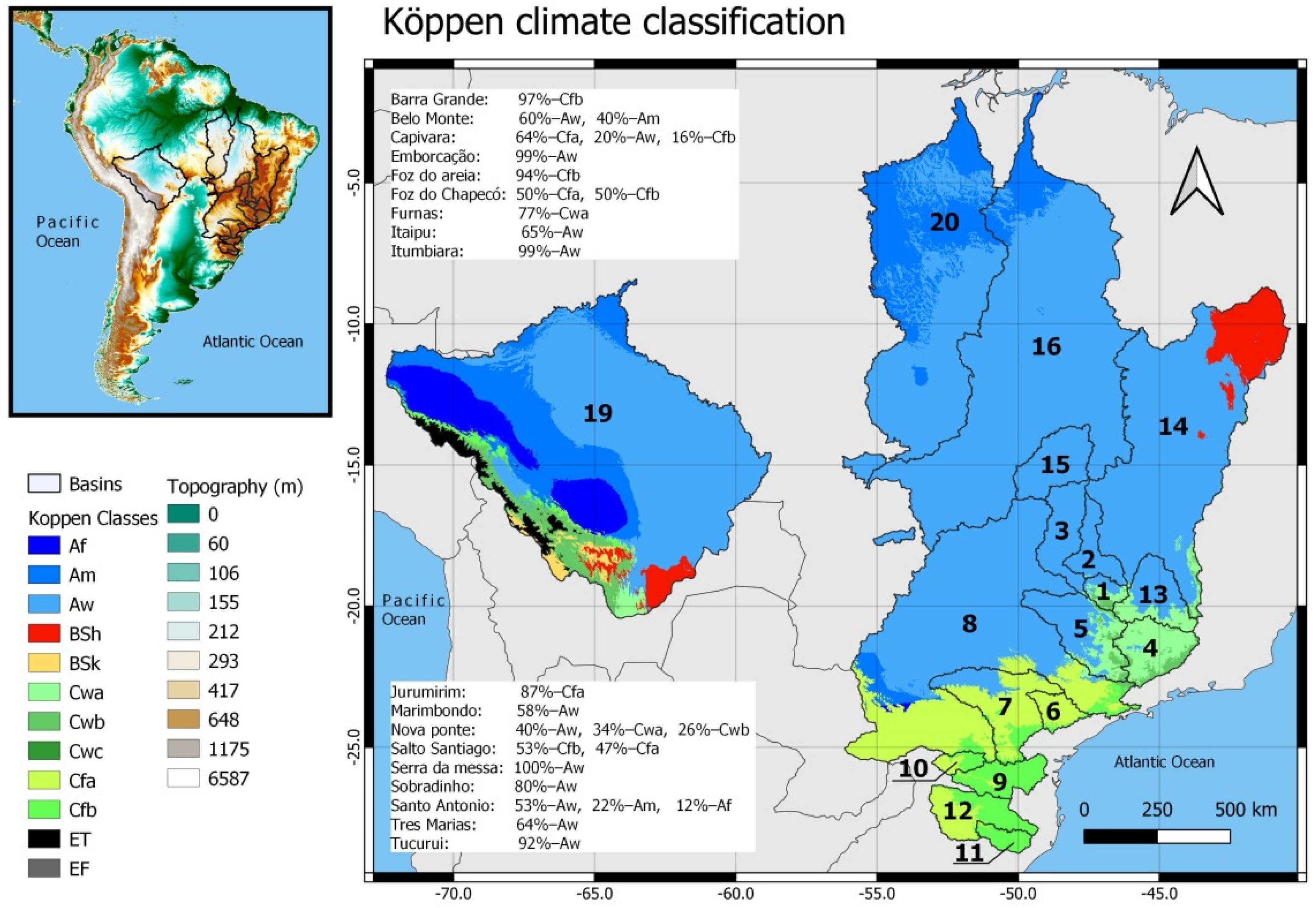


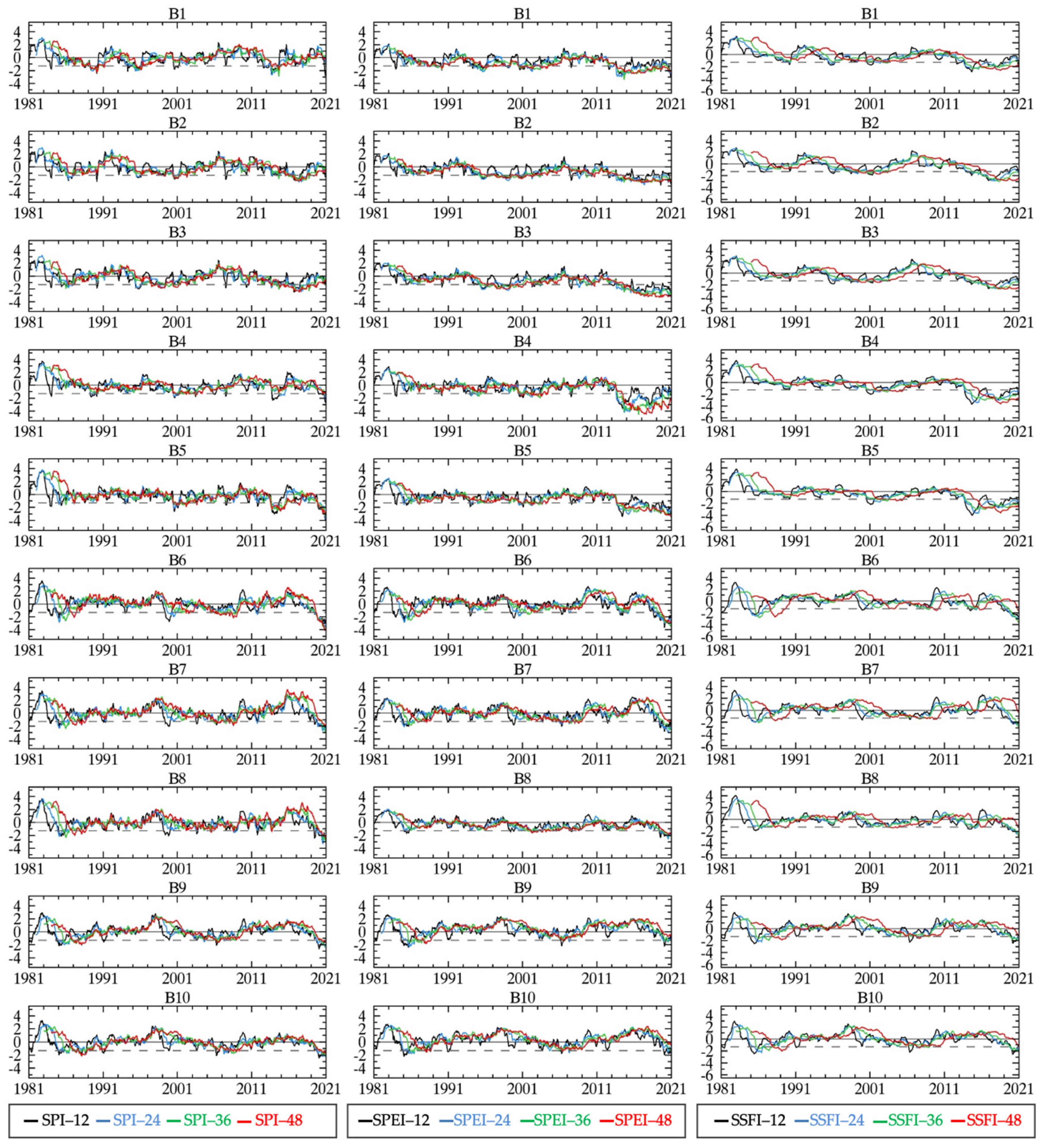



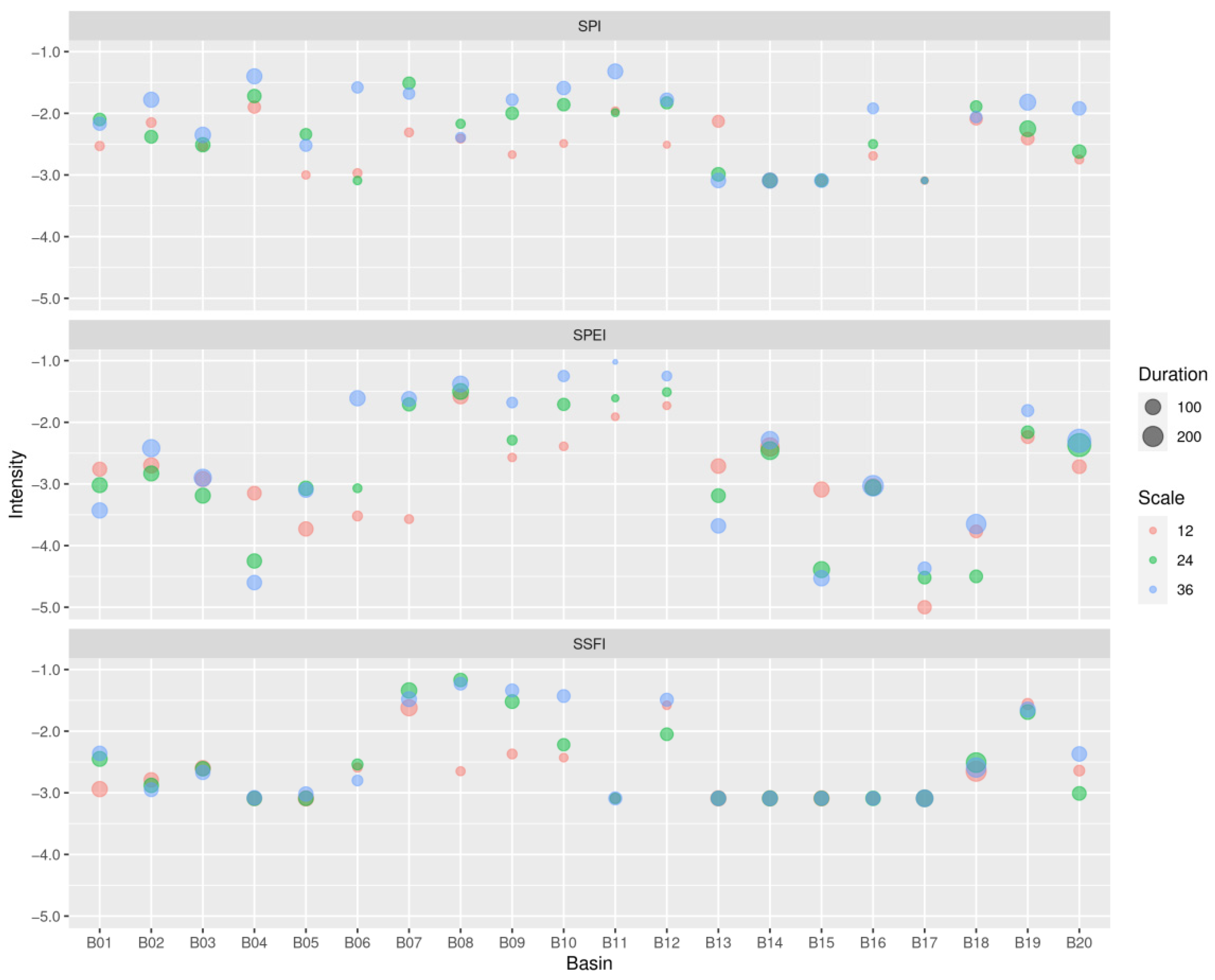






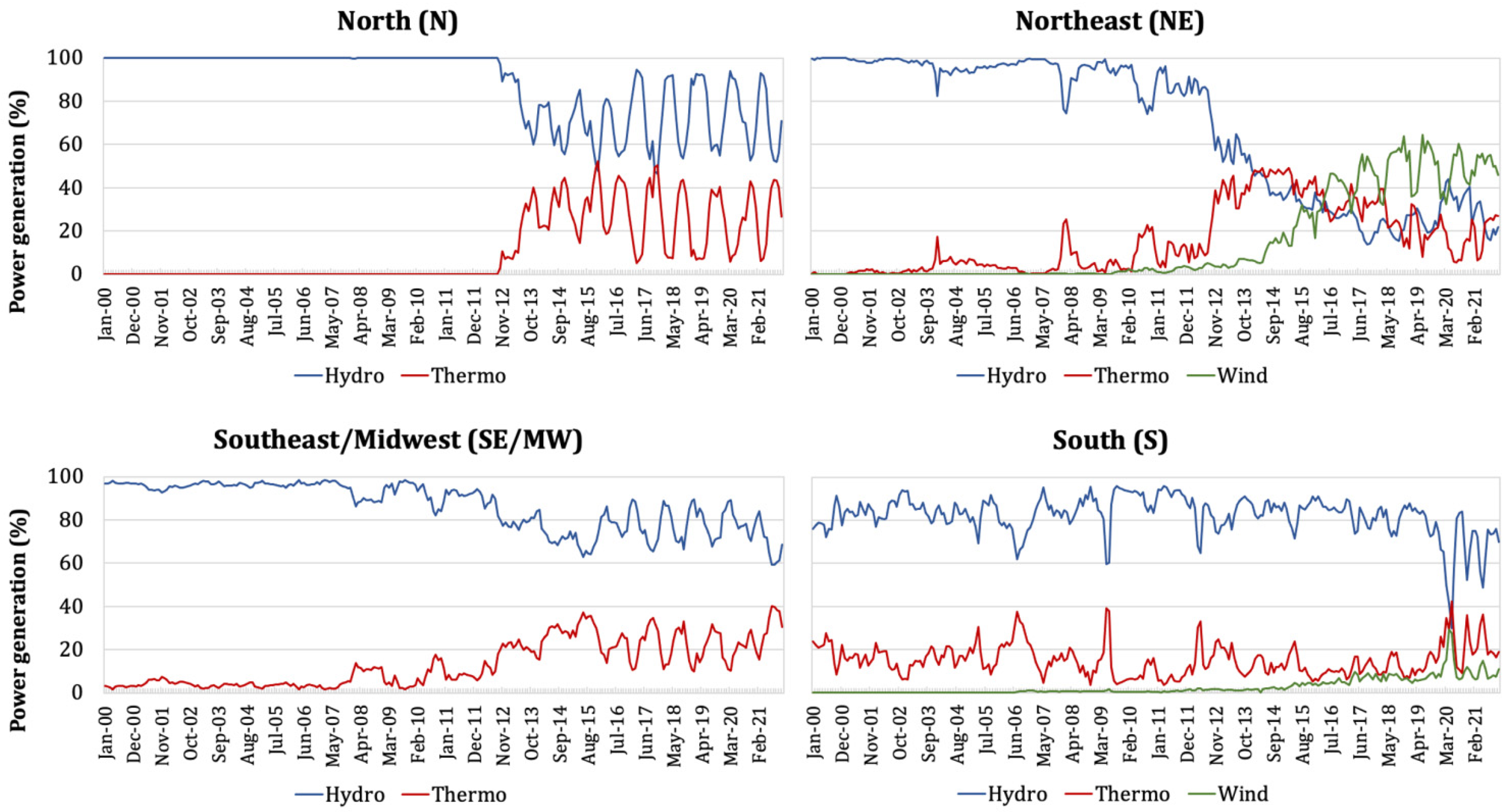
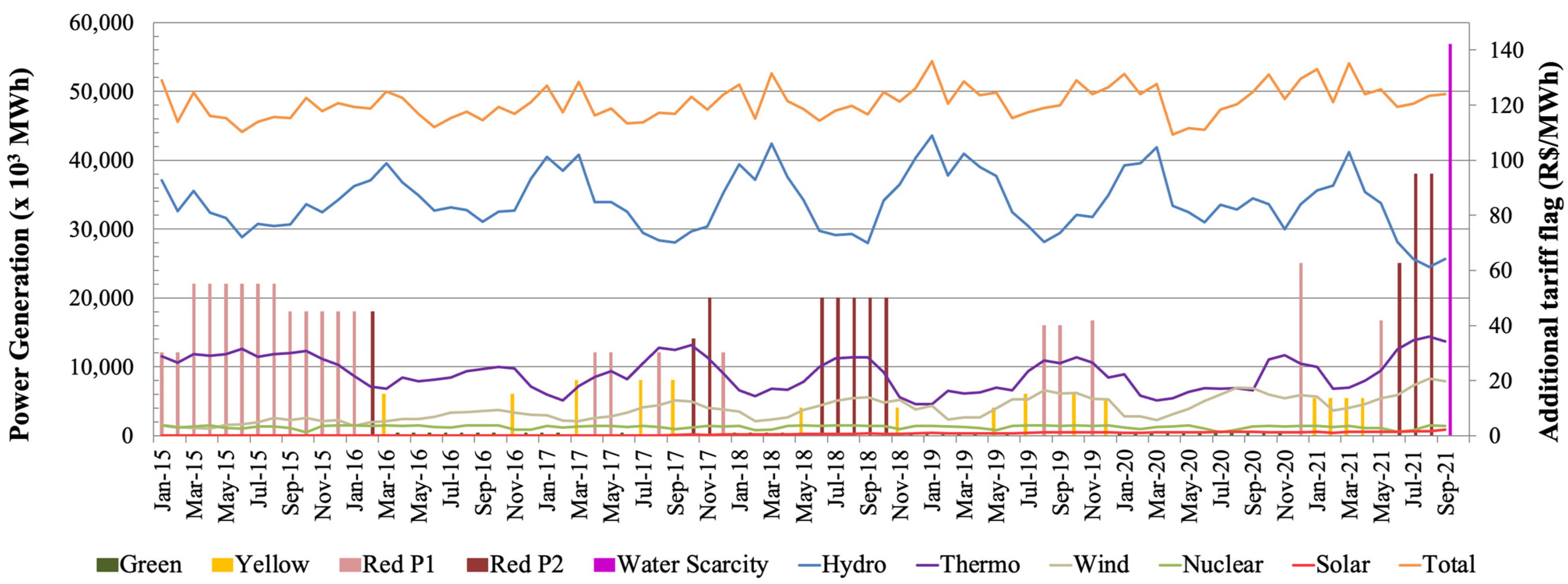
| Basin ID | HPP | Basin | Sub-Basin | River | Operation Start | Type | Useful Volume (hm³) | Power (MW) | Power Generation Subsystem | Importance for Power Generation by Subsystem (%) | Qnat Mean (m³/s) |
|---|---|---|---|---|---|---|---|---|---|---|---|
| B1 | Nova Ponte | Paraná | Paranaíba | Araguari | 1994 | R * | 10,380 | 510 | SE/MW | 11.13 | 293 |
| B2 | Emborcação | Paraná | Paranaíba | Paranaíba | 1982 | R * | 13,056 | 1192 | SE/MW | 10.72 | 473 |
| B3 | Itumbiara | Paraná | Paranaíba | Paranaíba | 1980 | R * | 12,454 | 2082 | SE/MW | 7.68 | 1511 |
| B4 | Furnas | Paraná | Grande | Grande | 1983 | R * | 17,217 | 1312 | SE/MW | 17.21 | 922 |
| B5 | Marimbondo | Paraná | Grande | Grande | 1975 | R * | 5260 | 1488 | SE/MW | 2.63 | 1849 |
| B6 | Jurumirim | Paraná | Paranapanema | Paranapanema | 1962 | R * | 3165 | 101 | SE/MW | 2.02 | 225 |
| B7 | Capivara | Paraná | Paranapanema | Paranapanema | 1977 | R * | 5725 | 635 | SE/MW | 1.91 | 1098 |
| B8 | Itaipu | Paraná | - | Paraná | 1984 | R-of-R ** | 19,000 | 7000 (Brazil) 14,000 (total) | SE/MW | - | 10,284 |
| B9 | Foz do Areia | Paraná | Iguaçu | Iguaçu | 1980 | R * | 5600 | 1676 | S | 29.8 | 726 |
| B10 | Salto Santiago | Paraná | Iguaçu | Iguaçu | 1980 | R * | 4094 | 1420 | S | 17.1 | - |
| B11 | Barra Grande | Uruguai | - | Pelotas | 2005 | R * | 2193 | 690 | S | 15.03 | 307 |
| B12 | Foz Chapecó | Uruguai | - | Uruguai | 2010 | R * | 74 | 855 | S | - | 1470 |
| B13 | Três Marias | São Francisco | - | São Francisco | 1962 | R * | 15,278 | 396 | SE/MW and NE | 1.15 | 623 |
| B14 | Sobradinho | São Francisco | - | São Francisco | 1982 | R-of-R ** | 28,669 | 1050 | NE | 58.23 | 2060 |
| B15 | Serra da Mesa | Tocantins-Araguaia | Tocantins | Tocantins | 1998 | R * | 43,250 | 1275 | SE/MW and N | 17.09 e 43.06 | 660 |
| B16 | Tucuruí | Tocantins-Araguaia | Tocantins | Tocantins | 1984 | R * | 32,000 | 8535 | N | 50.69 | 11,000 |
| B17 | Manso | Paraguai | - | Manso | 1999 | R * | 210 | 212 | SE/MW | - | 173 |
| B18 | Ponte de Pedra | Paraguai | - | Correntes | 2005 | R-of-R ** | 176 | 176 | SE/MW | - | 100 |
| B19 | Santo Antônio | Amazonas | Madeira | Madeira | 2012 | R* | 273 | 3568 | SE/MW and N | - | 18,624 |
| B20 | Belo Monte | Amazonas | Xingu | Xingu | 1998 | R-of-R ** | 439 | 11,000 | SE/MW and N | - | 3676 |
| Basin | SPI12 | SPI24 | SPI36 | SPI48 | SPEI12 | SPEI24 | SPEI36 | SPEI48 | SSFI12 | SSFI24 | SSFI36 | SSFI48 |
|---|---|---|---|---|---|---|---|---|---|---|---|---|
| B1 | 0.00 | 0.04 | 0.07 | 0.10 | −0.24 | −0.26 | −0.28 | −0.32 | −0.35 | −0.38 | −0.40 | −0.45 |
| B2 | −0.13 | −0.14 | −0.17 | −0.19 | −0.34 | −0.40 | −0.41 | −0.44 | −0.32 | −0.34 | −0.34 | −0.33 |
| B3 | −0.17 | −0.22 | −0.24 | −0.27 | −0.39 | −0.43 | −0.43 | −0.42 | −0.34 | −0.36 | −0.35 | −0.34 |
| B4 | −0.12 | −0.12 | −0.08 | −0.05 | −0.28 | −0.30 | −0.30 | −0.28 | −0.43 | −0.45 | −0.45 | −0.45 |
| B5 | −0.20 | −0.24 | −0.25 | −0.28 | −0.32 | −0.29 | −0.29 | −0.33 | −0.42 | −0.43 | −0.43 | −0.44 |
| B6 | −0.13 | −0.14 | −0.12 | −0.11 | −0.08 | −0.10 | −0.06 | −0.01 | −0.14 | −0.19 | −0.21 | −0.19 |
| B7 | 0.00 | 0.04 | 0.11 | 0.13 | −0.03 | −0.06 | −0.01 | 0.08 | −0.04 | −0.05 | −0.02 | 0.05 |
| B8 | −0.05 | 0.00 | 0.06 | 0.10 | −0.21 | −0.23 | −0.23 | −0.22 | −0.19 | −0.16 | −0.13 | −0.15 |
| B9 | 0.02 | 0.04 | 0.07 | 0.11 | 0.04 | 0.02 | 0.05 | 0.15 | −0.04 | −0.04 | −0.03 | 0.02 |
| B10 | −0.05 | −0.06 | −0.05 | −0.04 | 0.00 | 0.04 | 0.07 | 0.08 | −0.04 | −0.04 | −0.02 | 0.01 |
| B11 | 0.12 | 0.18 | 0.24 | 0.32 | 0.05 | 0.09 | 0.15 | 0.21 | −0.09 | −0.17 | −0.17 | −0.14 |
| B12 | 0.05 | 0.07 | 0.13 | 0.19 | 0.08 | 0.11 | 0.14 | 0.20 | −0.02 | −0.06 | −0.04 | 0.01 |
| B13 | −0.14 | −0.19 | −0.24 | −0.23 | −0.20 | −0.23 | −0.23 | −0.25 | −0.32 | −0.34 | −0.34 | −0.32 |
| B14 | −0.15 | −0.21 | −0.26 | −0.31 | −0.27 | −0.39 | −0.47 | −0.55 | −0.48 | −0.51 | −0.54 | −0.55 |
| B15 | −0.19 | −0.28 | −0.29 | −0.30 | −0.38 | −0.43 | −0.45 | −0.45 | −0.40 | −0.48 | −0.49 | −0.49 |
| B16 | −0.03 | −0.03 | −0.08 | −0.14 | −0.54 | −0.65 | −0.70 | −0.75 | −0.30 | −0.40 | −0.47 | −0.55 |
| B17 | −0.02 | −0.04 | −0.07 | −0.12 | −0.22 | −0.22 | −0.25 | −0.30 | −0.34 | −0.44 | −0.46 | −0.51 |
| B18 | −0.06 | −0.06 | −0.07 | −0.09 | −0.38 | −0.44 | −0.50 | −0.56 | −0.34 | −0.32 | −0.32 | −0.33 |
| B19 | 0.02 | 0.07 | 0.11 | 0.15 | −0.43 | −0.55 | −0.61 | −0.67 | −0.16 | −0.17 | −0.16 | −0.17 |
| B20 | 0.03 | 0.04 | 0.12 | 0.12 | −0.49 | −0.52 | −0.50 | −0.50 | 0.03 | 0.11 | 0.15 | 0.18 |
Publisher’s Note: MDPI stays neutral with regard to jurisdictional claims in published maps and institutional affiliations. |
© 2022 by the authors. Licensee MDPI, Basel, Switzerland. This article is an open access article distributed under the terms and conditions of the Creative Commons Attribution (CC BY) license (https://creativecommons.org/licenses/by/4.0/).
Share and Cite
Cuartas, L.A.; Cunha, A.P.M.d.A.; Alves, J.A.; Parra, L.M.P.; Deusdará-Leal, K.; Costa, L.C.O.; Molina, R.D.; Amore, D.; Broedel, E.; Seluchi, M.E.; et al. Recent Hydrological Droughts in Brazil and Their Impact on Hydropower Generation. Water 2022, 14, 601. https://doi.org/10.3390/w14040601
Cuartas LA, Cunha APMdA, Alves JA, Parra LMP, Deusdará-Leal K, Costa LCO, Molina RD, Amore D, Broedel E, Seluchi ME, et al. Recent Hydrological Droughts in Brazil and Their Impact on Hydropower Generation. Water. 2022; 14(4):601. https://doi.org/10.3390/w14040601
Chicago/Turabian StyleCuartas, Luz Adriana, Ana Paula Martins do Amaral Cunha, Jessica Anastácia Alves, Larissa Milena Pinto Parra, Karinne Deusdará-Leal, Lidiane Cristina Oliveira Costa, Ruben Dario Molina, Diogo Amore, Elisangela Broedel, Marcelo Enrique Seluchi, and et al. 2022. "Recent Hydrological Droughts in Brazil and Their Impact on Hydropower Generation" Water 14, no. 4: 601. https://doi.org/10.3390/w14040601
APA StyleCuartas, L. A., Cunha, A. P. M. d. A., Alves, J. A., Parra, L. M. P., Deusdará-Leal, K., Costa, L. C. O., Molina, R. D., Amore, D., Broedel, E., Seluchi, M. E., Cunningham, C., Alvalá, R. C. d. S., & Marengo, J. A. (2022). Recent Hydrological Droughts in Brazil and Their Impact on Hydropower Generation. Water, 14(4), 601. https://doi.org/10.3390/w14040601









